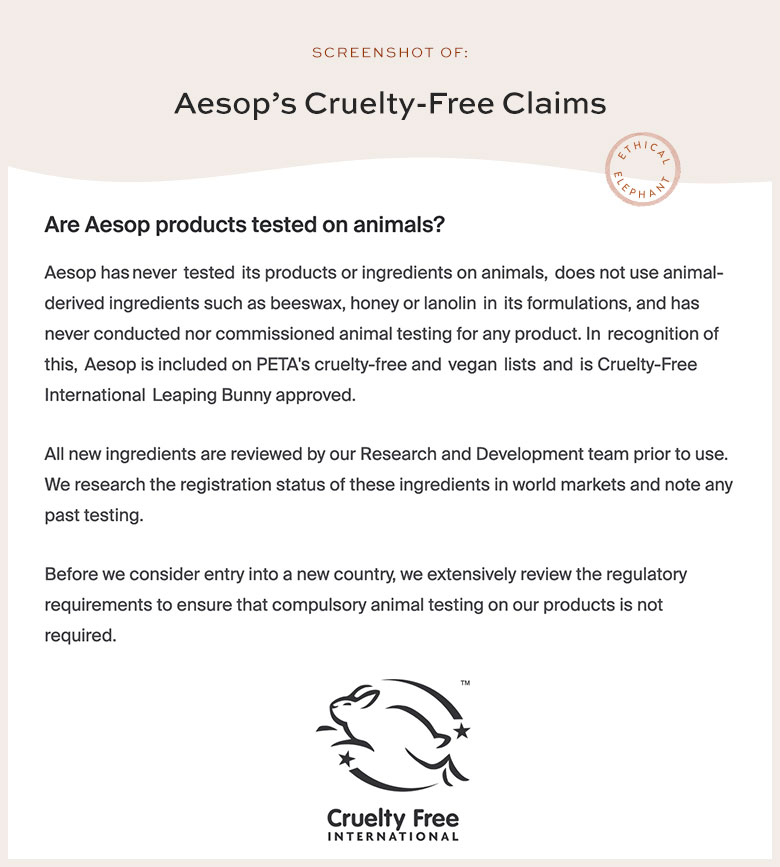The quest for ethical consumerism has precipitated growing scrutiny of numerous brands, and Aesop is no exception. Renowned for their high-quality skin care products, the Australian company proclaims a commitment to being cruelty-free. Yet, the fundamental question persists: Is Aesop truly animal cruelty-free? To navigate this inquiry, it is essential to dissect their claims while also situating them within the broader context of the cosmetics industry.
At its core, the term “cruelty-free” implies that a company does not engage in animal testing in any shape or form. However, the criteria and perceptions surrounding this label can be nebulous. Aesop asserts that they do not test their products on animals; they also maintain that they do not utilize ingredients tested on animals, aligning their practices with the ethical expectations of conscious consumers. Yet, this nuanced stance becomes more complex when one delves deeper into the company’s operations and the regulatory frameworks governing cosmetics.
In many instances, brands that tout cruelty-free certifications may still be implicated in practices that raise ethical dilemmas. A cursory inspection of Aesop’s supply chain reveals that while the brand does not independently conduct animal testing, they source ingredients from suppliers who may do so under certain jurisdictions. Regulatory pressures can compel testing in specific markets, particularly in countries like China, which until recently mandated that cosmetics sold within its borders undergo animal testing. As a result, Aesop’s global footprint could inadvertently perpetuate a cycle of animal testing, even if the brand’s direct involvement is ostensibly absent.
This scenario raises a pertinent question about corporate responsibility: to what extent should a brand be held accountable for the practices of its suppliers? Aesop’s commitment to ethical sourcing and non-testing seems laudable, yet it begs for scrutiny. The interplay between ethical sourcing and practical logistics plays a pivotal role in defining a company’s reputation as genuinely cruelty-free. A vigilant consumer must reconcile the laudatory claims with the broader implications of the supply chain dynamics.
Another critical factor to consider is the company’s transparency. Transparency is imperative in fostering trust between consumers and brands, particularly in the context of ethical consumerism. Aesop has made strides in openly communicating their policies and practices, yet gaps linger. For example, they offer limited insight into their supplier auditing processes or how they ensure that third-party manufacturers adhere to their cruelty-free claims. This vagueness can nourish skepticism among consumers who demand unequivocal accountability in the brands they support.
Beyond the in-house practices, there is the matter of the brand’s placement within the ethical framework of the broader industry. Aesop finds itself among an increasing plethora of cosmetics companies—some truly societal pariahs and others that genuinely operate under ethical paradigms. The consumer landscape is replete with brands that have independently established rigorous cruelty-free standards and have sought out certification from organizations like PETA or Leaping Bunny. Aesop’s absence from these certification lists raises eyebrows and evokes a sense of wariness amongst discerning buyers who seek third-party validation.
The philosophy and values that underpin a brand often disambiguate their authenticity, and Aesop devotes considerable effort to market their image as an ethically-conscious industry player. Their focus on minimalistic packaging, sustainable sourcing, and sophisticated branding appeals to consumers who value aesthetics as much as ethics. This branding prowess fuels an aura of prestige and desirability around Aesop products, which can obscure the complexities involved in their ethical claims.
Myriad consumers are beguiled by the luxurious experience that Aesop promises. Their artisanal products are often celebrated for their refined formulations and harmonious blends. However, when the allure of luxury collides with the core ethical tenets of animal welfare, one must thoughtfully consider personal values. Is it acceptable to indulge in such products if there remains a shadow of doubt regarding their cruelty-free status?
As the discourse surrounding ethical consumption continues to evolve, awareness of these nuanced dynamics is paramount. As more consumers prioritize cruelty-free products, brands—including Aesop—must reassess their practices and emerge with greater transparency and accountability. Shifting consumer expectations can compel brands to take definitive stances and provide clear pathways for consumers seeking genuinely ethical options.
Furthermore, the pursuit of true cruelty-freedom should extend beyond simple product assertions. Engaging in informative dialogues, supporting advocacy organizations, and demanding stringent regulations can amplify the call for ethical standards within the cosmetics industry. The cry for animal rights cannot simply be an afterthought; it should resonate as a cornerstone of innovation in product development.
In conclusion, Aesop’s claims of being cruelty-free invite an in-depth exploration, which unveils a plethora of considerations. While the brand’s narrative is compelling, the realities of animal testing within the supply chain, transparency issues, and industry practices compel consumers to proceed with a discerning eye. Conscious decision-making in today’s consumer landscape is more than a matter of preference; it is an ethical imperative that asserts a demand for authenticity. The responsibility lies not solely with the brands but also with consumers who wield purchasing power to advocate for a more humane world.








